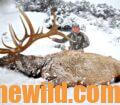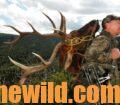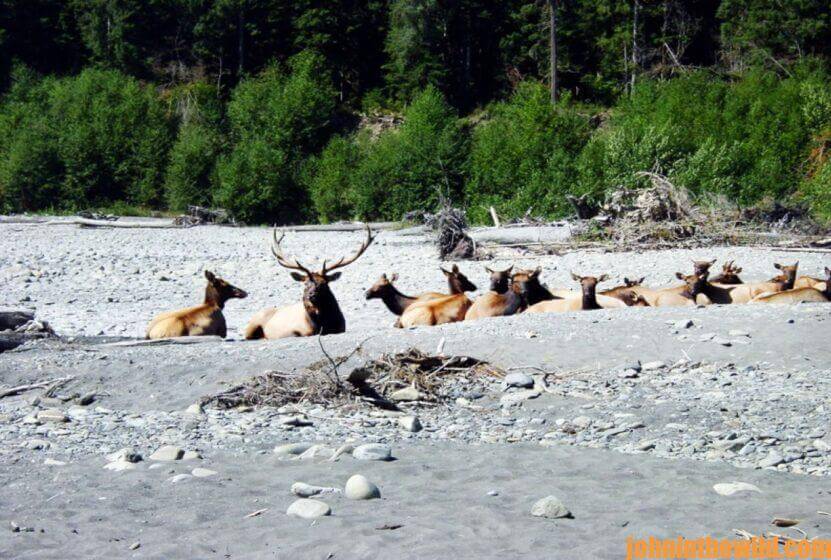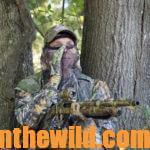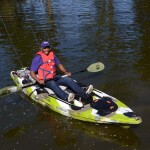Editor’s Note: Mike Lee, formerly from Montana but now living in Oregon, has been hunting elk for almost four decades – both on Montana and Oregon public lands. According to Lee, “Because I like to work from the ridgeline of mountains down to the lower elevations, I hunt in trees and dark timber most of the time. So, if I’m calling an elk from down below me, more than likely, I’ll meet him in the timber.”
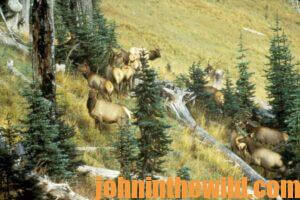 One of the places I hunt for Roosevelt elk in Oregon only has a 4-day season, and you can take any bull that you see. So, we don’t usually pass-up spikes or small bulls. Remember, we’re trying to put meat in the freezers for our families. On the first day of our hunt one time, our party had taken one bull – a small spike. On the second day of the hunt, rain moved in, and we went to an area to hunt. But two vehicles were already parked where we had planned to park. Just as we got out of the truck to start looking, one of the hunters in another truck walked over to us and said, “Two of our hunters are down in this drainage.” So, we decided to go around the mountain and look at the side of the mountain that these guys couldn’t see. We got out of our vehicle, went on the other side of the mountain from where the hunters were and started glassing the canyon when the fog rolled in on us. Sometimes the fog would be so thick we couldn’t see down in the canyon. Then, the fog would drop down almost to the bottom of the canyon. The fog played this trick on us several different times.
One of the places I hunt for Roosevelt elk in Oregon only has a 4-day season, and you can take any bull that you see. So, we don’t usually pass-up spikes or small bulls. Remember, we’re trying to put meat in the freezers for our families. On the first day of our hunt one time, our party had taken one bull – a small spike. On the second day of the hunt, rain moved in, and we went to an area to hunt. But two vehicles were already parked where we had planned to park. Just as we got out of the truck to start looking, one of the hunters in another truck walked over to us and said, “Two of our hunters are down in this drainage.” So, we decided to go around the mountain and look at the side of the mountain that these guys couldn’t see. We got out of our vehicle, went on the other side of the mountain from where the hunters were and started glassing the canyon when the fog rolled in on us. Sometimes the fog would be so thick we couldn’t see down in the canyon. Then, the fog would drop down almost to the bottom of the canyon. The fog played this trick on us several different times.

Finally, we looked up and spotted the other two guys – about 400 yards above us, looking down into the same canyon as we were. Once the fog moved up the canyon, the other two hunters couldn’t see down into the bottom of the canyon. Through my binoculars, I spotted a herd of elk coming up the canyon, moving along the opposite side of the mountain from the side of the mountain where we were. When the elk couldn’t see us, we moved down the canyon and set-up to take the elk once the fog cleared. The fog did clear, and we took small 4×4 and 3×4 bulls. When the shooting started, the two guys at the top of the canyon came down the trail we were on straight to us and said, “You’ve taken our elk.” I explained, “This is public-land hunting. No one owns any part of this land. Therefore, whoever finds the elk and gets to them first has the right to take them.” These guys hadn’t even seen the elk, until we started shooting. I told them, “If you want to call the state police, you certainly can. I was a police officer. I can give you the state police’s number. If you want to talk to the game troopers who patrol this area, I can give you the troopers’ numbers, because they are friends of mine.” Five bulls were in that herd, and we were able to get two of them. We recovered our bulls, butchered them, carried them up the mountain and were finished hunting by dark.
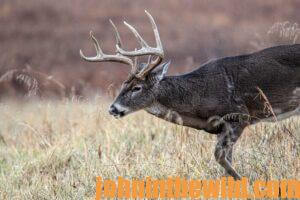
Although I’m primarily an elk hunter, on the last day of white-tailed deer season one year, I spotted two bucks fighting out in a field on public land, not too far from town. This area receives a lot of hunting pressure. Most guys just walk through this property, but there’s a little hill on the edge of it. If you walk to the edge of the hill, you can look over a lot of open country. So, on the last day of hunting season, I decided I’d walk out on that little hill and sit on it until dark and close out my hunting season there.
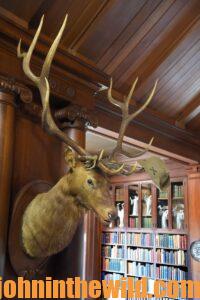
Fifteen minutes after I got to the spot where I was glassing, I spotted a group of does. I had a doe tag, so I shot one of the does at about 140 yards. I still had plenty of daylight left and left the doe there. About 10 minutes before the end of legal shooting time, I saw a buck coming out of the willows on one side of the area I was glassing. Suddenly, another buck showed up, but I didn’t know from where he’d come. The two bucks started fighting and pushing each other around, but finally, took a break from fighting. I picked the biggest buck out and fired, and the buck dropped. The other buck stood looking at the buck I just had shot and then slowly wandered off. This buck was an 8-point eastern count. His main beam was out past his ears, his points were about 5 – 6 inches long, and his antlers were very symmetrical. He was a really-nice whitetail.
I had filled both my deer tags in the last few hours of Montana’s deer season. I dragged the whitetail buck up to the place where the doe had fallen and field dressed both deer. I put a rope around the doe’s neck and a half hitch on her nose and dragged her back to the truck. Then I drug the buck the 800 yards back to the truck. I’d brought a flashlight with me, which made finding both downed deer easier. Field dressing them and dragging them was not nearly as difficult as it would’ve been if I hadn’t had my light.
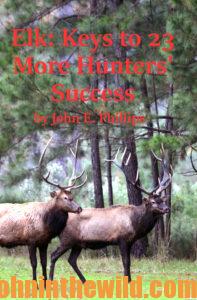
To learn more about hunting elk successfully, check out John E. Phillips’ book, “Elk: Keys to 23 More Hunters’ Success,” available in Kindle, print and Audible at https://www.amazon.com/gp/product/B09B2H9V6Y/ref=dbs_a_def_rwt_hsch_vapi_tkin_p1_i2.
And see John E. Phillips’ book, “Elk: Keys to 25 Hunters Success,” available in Kindle, print and Audible versions at https://amzn.to/2IDszQk. You may have to copy and paste this click into your browser. When you click on these books, notice on the left where Amazon allows you to read and hear 10% of the books for free. On the right side of the page and below the offer for a free Audible trial, you can click on Buy the Audible with one click.

